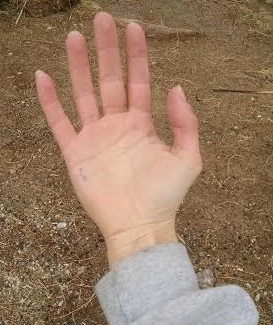Ape Hand: Difference between revisions
No edit summary |
No edit summary |
||
| Line 4: | Line 4: | ||
== Introduction == | == Introduction == | ||
[[File:Ape Hand.jpg|thumb]] | [[File:Ape Hand.jpg|thumb]] | ||
Ape hand is a physical deformity in humans causing inability to abduct or oppose the thumb thereby causing the thumb little or no abduction and opposition. Abduction of the thumb is the ability to move the perpendicular (90°) away from the plane of the palm. Opposition is the ability of the first metacarpal to swing over the palmar surface of the [[Wrist and Hand|hand]] so that the thumb and the tip of the little finger are in contact. The thumb may also experience limited flexion and extension. | Ape hand is a physical deformity in humans causing inability to abduct or oppose the thumb thereby causing the thumb little or no abduction and opposition. <ref>Anatomy Tables - Hand. Available from; https://web.archive.org/web/20080118014710/http://anatomy.med.umich.edu/musculoskeletal_system/hand_tables.html (Last accessed 11/Oct/2020)</ref> Abduction of the thumb is the ability to move the perpendicular (90°) away from the plane of the palm. Opposition is the ability of the first metacarpal to swing over the palmar surface of the [[Wrist and Hand|hand]] so that the thumb and the tip of the little finger are in contact. The thumb may also experience limited flexion and extension. | ||
== Mechanism of Injury / Pathological Process == | == Mechanism of Injury / Pathological Process == | ||
Revision as of 11:38, 11 October 2020
Top Contributors - Kehinde Fatola, Joseph Ayotunde Aderonmu, Ahmed M Diab, Kim Jackson and Shaimaa Eldib
Introduction[edit | edit source]
Ape hand is a physical deformity in humans causing inability to abduct or oppose the thumb thereby causing the thumb little or no abduction and opposition. [1] Abduction of the thumb is the ability to move the perpendicular (90°) away from the plane of the palm. Opposition is the ability of the first metacarpal to swing over the palmar surface of the hand so that the thumb and the tip of the little finger are in contact. The thumb may also experience limited flexion and extension.
Mechanism of Injury / Pathological Process[edit | edit source]
The mechanism of injury are deep injuries to the arm, forearm and wrist causing damage to the median nerve thereby causing impairment to the thenar muscles and opponents policis
Clinical Presentation[edit | edit source]
The condition is a part of median nerve palsy and it typically present with problems moving the thumb in various planes. There is limited range of motion of the thumb.
Management / Interventions[edit | edit source]
Surgery may be prescribed depending on the severity of the deformity, anti-inflammatory drugs and corticosteroid injections may also be used. Occupational therapy, Physiotherapy and dynamic splinting which pulls the thumb in opposition may prevent excess in deformity. It is however possible to recover without treatment.
Differential Diagnosis[edit | edit source]
References[edit | edit source]
- ↑ Anatomy Tables - Hand. Available from; https://web.archive.org/web/20080118014710/http://anatomy.med.umich.edu/musculoskeletal_system/hand_tables.html (Last accessed 11/Oct/2020)







